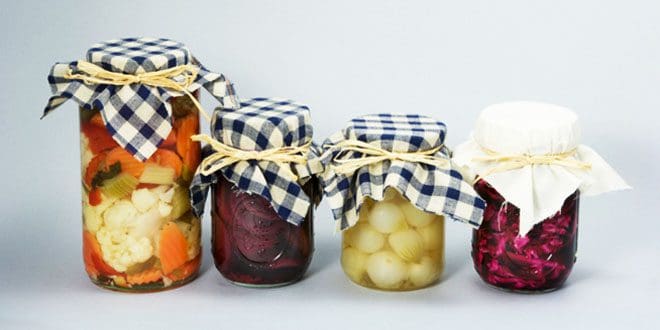Fermented foods are extremely beneficial because they produce a more favourable population of bacteria in the intestines. This can reduce many types of chronic digestive and bowel symptoms and even overcome disease. Fermented foods are a potent way to use food to add to the diversity of good species (micro-organisms) inhabiting our digestive system. Normal gut flora has more than 600 different species and most available commercial probiotic products contain a maximum of nine species. After any course of antibiotics it is necessary to repopulate our intestine with as wide a variety of healthy micro organisms as possible. Many people with chronic digestive and bowel problems have a host of bad species in their gut and not enough good or healthy species (probiotics). Until this is reversed you cannot restore your health.
Dairy sourced
- Yoghurt – purchase full fat, unsweetened, unflavoured and preferably organic or biodynamic. This type of yoghurt may be purchased or made at home by using prepared yoghurt as the starter or a commercial product like EasyYo or Progurt may be used. Avoid the sweetened choices, as sugar kills the probiotics. Coconut yogurt is a healthy choice
- Kefir – is cultured probiotic milk; it’s easy to make at home from commercially available freeze dried granules, which are available from health stores.
- Cheese – Camembert, Brie and mouldy cheeses are fermented. Always buy these fresh and do not allow them to age for too long.
- Crème fraiche – is cultured cream. After being seeded with probiotics it is cultured for 3 – 4 days before being churned.
- Cultured buttermilk – is the liquid portion of the butter churning process. It may be flavoured with berries, coffee or vanilla and some stevia drops to make probiotic rich drinking yoghurt. It is often used in flap jacks, but the cooking kills the beneficial bacteria.
Vegetable sourced
- Sauerkraut – traditional European winter food. It is cabbage based with other available vegetables added, then salted and naturally fermented with fresh liquid whey from either aged yoghurt or kefir.
- Kalekraut – is very similar to Sauerkraut but is made with kale instead of cabbage. It is made the same way and the resultant product tends to be less sour in flavour.
- Kim Chi – is the national dish of Korea and is made in a similar way to sauerkraut with the addition of many other vegetables, spices and especially chilli. It also tends to be quite highly salted and many types have added salted fish.
Mauritian Cabbage Pickle
- ½ a firm cabbage, finely sliced.
- 3 carrots, julienned
- ¼ pound fresh green beans, thinly sliced
Other vegetables in season may be added to your taste
Place the vegetables in the sun in a thin layer to partially dehydrate
Meanwhile
- 2 onions thinly sliced lengthways, gently fried in 3 tablespoons of virgin coconut oil.
- Add 3cm fresh ginger, grated.
- 1 whole garlic onion; peeled and passed through presser.
- 1 teaspoon freshly ground black pepper
- 1 tablespoon turmeric, depending on taste
- 1 tablespoon white mustard seed and gently heat this mixture til turmeric becomes dark in colour.
Turn off heat and add the sliced vegetables.
Add ¼ cup of cold pressed extra virgin olive oil and apple cider vinegar (with the mother).
Celtic sea salt may also be added to taste.
The pickle is ready for use and is best stored in the refrigerator and improves with age.
Grain sourced
Sourdough bread – by definition this bread uses wild yeasts for fermentation, which makes the nutrients far more bio available. Gluten free varieties are not available commercially, although there are many recipes on the net.
Soy or Rice Sourced
- Natto – definitely not for the feint hearted. This food is eaten with gusto in Japan but in western countries it has not gained the same popularity. Natto is soy beans that have been fermented with a bacteria and the product is distinctive in both taste and appearance.
- Miso – is a fermented product of soy or barley or rice. Some brands have a mixture of these, which makes it a gluten free or very low gluten product. Miso may be enjoyed as a meal starter or soup and may be added to meals to impart a distinctive salty-sweet flavour and beneficial nutrients.
- Tempeh is blocks of soy bean that have been fermented with a beneficial fungus. It may be sliced and added to salads or stir fried and used in the same way as tofu.
Plant Sourced
- Kombucha Tea – requires sweetened tea for the growth of this probiotic rich drink. It is made by adding a kombucha starter to cooled sweetened tea and left to ferment at room temperature til sweetness is replaced by a more acidic taste.
- Apple cider vinegar – organic is easily purchased and the best probiotic value is found in a product with a ‘mother’. The mother is sediment on the bottom of the bottle and this provides a rich source of probiotic.
- Vinegar – is probably our best known household fermented food and it is produced from the fermentation of wines, fruits or flowers. Inferior vinegars are simply diluted acetic acid and are definitely not a healthy alternative. These are often simply identified as white or malt vinegar.


What about Kombucha?
we love Kombucha